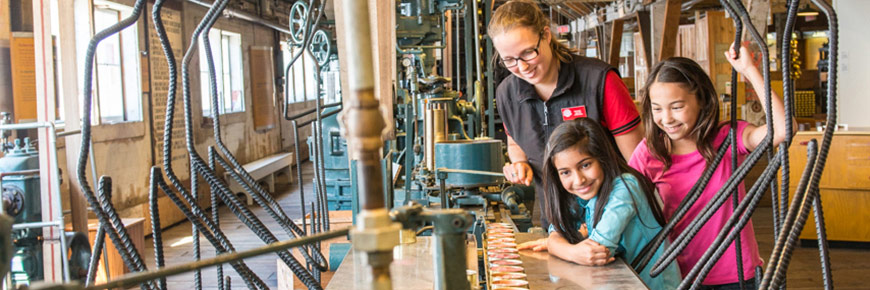
School programs
Gulf of Georgia Cannery National Historic Site
Situated atop wooden pilings over the Fraser River where mountains of fish once crowded the receiving dock you can smell the sea and hear the lap of waves beneath the Cannery floorboards.
Built in 1894 in the historic fishing village of Steveston, the Gulf of Georgia Cannery was the largest building of its kind and the leading producer of canned salmon in BC. It stopped canning salmon in the 1930s but remained active as a net loft, fish depot and later as a herring reduction plant. Now a national historic site and museum, exhibits include a functioning salmon canning line, a herring reduction plant, and West coast fish and fishing methods. Check the Gulf of Georgia Cannery Society website for our latest feature exhibit.
The Cannery is the ideal place for your students to discover B.C.’s social history, explore the science and politics of fish and the fishing industry and experience the stories of this place and its people through interactive programs, exhibits and films.
Guided tour and machine demonstration
(Suitable for all ages, including ESL)
Try your hand at peughing a salmon at the receiving dock and follow its journey from fishing net to airtight can. See the fish scales that still cover the walls and learn about the lives of the people who worked on the line 12 hours a day. On the herring reduction plant tour, students will find machinery that was adapted from other industries including dairy, wine and pulp and paper. The 20 minute film Journey Through Time is a perfect introduction to the history of the Cannery and BC's fishing history for all ages.
From sea to me (Grades K-1)
Fishing, sliming, salting and sealing are just a few of the stages involved in canned fish processing. In this engaging, hands-on program, students explore the steps of the salmon canning line. Through picture book stories, puzzles and a scavenger hunt, students work and learn cooperatively to follow the stages from ocean or river to lunch box.
Fishy business: A century of change (Grades 2-3)
Fish and fishing are a significant part of the historic fabric for many BC coastal communities. This interactive program teaches about West Coast fish and fishing methods of yesterday and today. Students experience the modern day challenges of the fishing business through role play. They will catch weigh, sort and sell a variety of fish.
Salmon people: Coast Salish Fishing (Grades 4-5)
Long before the development of canneries, Aboriginal people fished along the banks of the Fraser River, including at the site of present- day Steveston. Using object-based inquiry, students explore the significance of fish and compare fishing and preservation methods.
Cannery stories (Grades 4-6)
What was life like for the people who lived and worked in one of B.C.'s cannery towns? The Cannery's general store serves as the backdrop for a detective game. Students will work in teams to discover the identity of six cannery workers. Conversations with the store clerks, access to primary sources and artifact replicas provide the clues that will reveal the personal story of these workers and bring the multicultural history of B.C.'s fishing industry to life.
Machines at work (Grade 5)
Through the design of their own compound machine and a close-up look at a real canning line in action, students will gain a greater understanding of the science of forces and simple machines.
Seafood for thought (Grade 6-9)
What is ocean-friendly seafood? The world ocean is a precious resource that is affected by climate change, fishing, pollution, and habitat destruction. Using drama techniques, students analyze the marine food web and compare fishing methods to find the best choices available for themselves and their families.
My monster cannery (Grade K to 6)
Based on the children's book My Monster Cannery, this interdisciplinary resource kit uses music, rhythmic movement, and song to develop language skills and to enhance historical understanding. Students will respond to texts, perform tableaux and take on the mantle of the expert.
BC's Fishing history (Grade 10)
How is the history of fishing linked to today's fishing industry? Drama techniques are used to immerse students in B.C.'s fishing history both past and present. Students will analyze primary and secondary sources, engage in debate, and participate in a fishing simulation.
Teacher planning
Want to learn more about the Cannery and our programs? Bring your school ID and receive one complimentary admission to the Cannery.
Help your students prepare for their visit with our teacher resource packages. Visit our website at www.gulfofgeorgiacannery.org to find a pdf resource for your program.
Getting here
The Cannery has a large pay parking lot with bus drop off. Parking is free for drivers bringing program participants. Please get your complimentary pass when you arrive.
A transit bus stop is located next to the Cannery. For information on public transit options, visit www.translink.bc.ca.
During your stay
The Cannery is fully wheelchair accessible.
Space for lunch inside the Cannery is limited and subject to availability. Packed lunches can be enjoyed in Fisherman’s Park just outside the Cannery doors. To arrange lunch inside the Cannery, please inform our staff at the time of booking.
Making a booking
Phone
Email
Fax Phone number:
+1 (604) 664-9137
- Advanced booking is required
- 18 student minimum
- Teachers, parents and chaperons are admitted free of charge to a maximum ratio of one chaperone to 5 students
- Date modified :